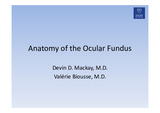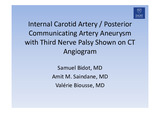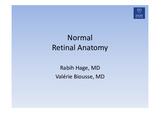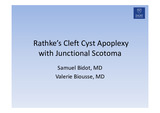The Emory Eye Center Neuro-Ophthalmology Collection contains a variety of lectures, videos and images relating to the discipline of neuro-ophthalmology created by faculty at Emory University in Atlanta, GA.
NOVEL: https://novel.utah.edu/
TO
Filters: Date: "2015" Collection: "ehsl_novel_eec"
1 - 25 of 8
| Title | Description | Creator | ||
|---|---|---|---|---|
| 1 |
 |
Anatomy of the Ocular Fundus | A review of normal features of the ocular fundus. Fundus photography using various techniques illustrate anatomic features of the ocular fundus. - Figure 1 : A) Color fundus photograph of the left optic disc and peripapillary retina showing a normal optic disc, retinal arteries, retinal veins, and... | Devin D. Mackay, MD; Valérie Biousse, MD |
| 2 |
 |
Internal Carotid Artery / Posterior Communicating Artery Aneurysm with Third Nerve Palsy Shown on CT Angiogram | Internal Carotid Artery / Posterior Communicating Artery Aneurysm with Third Nerve Palsy Shown on CT Angiogram ; anatomic description of vascular and bony findings on the CTA. - Figure 1 : 51 year-old man complaining of painful binocular diplopia. Orange arrows indicate the direction of gaze. In p... | Samuel Bidot, MD; Amit M. Saindane, MD; Valérie Biousse, MD |
| 3 |
 |
Normal Retinal Anatomy | Normal posterior vitreous, retinal and chroroidal anatomy (pictures, fluorescein angiography and optical coherence tomography). Figure 1: Normal fundus photograph of the left eye o a : Optic disc and fovea o b : Foveal reflex in young patients o c : Macular and foveal areas share the same center o d... | Rabih Hage, MD; Valérie Biousse, MD |
| 4 |
 |
Occipital Pyogenic Abscess with Homonymous Hemianopia | This is a case of right occipital abscess with a left homonymous hemianopia. Number of Figures and legend for each: 8 figures Figure 1: Humphrey visual fields: Dense left homonymous hemianopia Figure 2: T2-weighted axial MRI : Round, hyperintense lesion (yellow arrow) in the right occipital lobe sur... | Rabih Hage, MD; Valérie Biousse, MD |
| 5 |
 |
Ocular Fundus Examination | Review of various techniques of ocular fundus examination, including direct ophthalmoscopy, binocular indirect ophthalmoscopy, slit lamp binocular indirect ophthalmoscopy, and fundus photography. Advantages and disadvantages of each technique are discussed. | Devin D. Mackay, MD; Valérie Biousse, MD |
| 6 |
 |
Radiologic Appearance of Unilateral Sphenoid Wing Hypoplasia in Neurofibromatosis Type I | MRI features of greater wing sphenoid hypoplasia in the setting of neurofibromatosis type 1. - Figure 1 : Orbital MRI with contrast showing right greater sphenoid wing hypoplasia. The lack of bone tissue leads to herniation of the right temporal lobe into the orbit, pushing forward the orbital conte... | Samuel Bidot, MD; Amit M. Saindane, MD; Valérie Biousse, MD |
| 7 |
 |
Rathke's Cleft Cyst Apoplexy with Junctional Scotoma | MRI features of Rathke's cleft cyst apoplexy. - Figure 1 : Humphrey visual fields at initial presentation - Figure 2 : Brain MRI without contrast at initial presentation - Figure 3 : Brain MRI with contrast at initial presentation - Figure 4 : Postoperative Humphrey visual fields | Samuel Bidot, MD; Amit M. Saindane, MD; Valérie Biousse, MD |
| 8 |
 |
Toxic Retinopathy: Deferoxamine Toxicity | Number of Figures and legend for each: 6 figures Figure 1: Goldmann perimetry showing large cecocentral scotomas in both eyes Figure 2: Fundus photograph of the right eye demonstrating hypopigmentation of the peripapillary and perifoveal retinal pigment epithelium (RPE) with subfoveal yellow lesions... | Will Pearce, MD; Valérie Biousse, MD |
1 - 25 of 8
